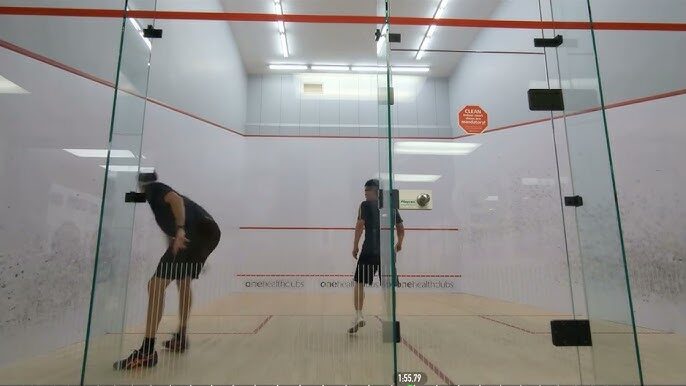Squash is more than just a fast-paced sport; it’s a full-body workout that helps improve fitness, burn calories, and promote weight loss. Whether you’re a seasoned player or someone considering picking up the racquet for the first time, you may not realize that playing squash can be a highly effective way to shed those extra pounds while having fun. In this blog, we’ll dive into how squash aids in weight loss, its additional health benefits, and how you can maximize your efforts on the court.
What is Squash?
Squash is a racquet sport played indoors where two players (singles) or four players (doubles) take turns hitting a rubber ball against the front wall. The goal is to outmaneuver your opponent by hitting the ball in such a way that they can’t return it. The game demands quick reflexes, agility, and intense cardiovascular effort, making it a high-intensity workout. As a result, it can help you burn a significant amount of calories while simultaneously building muscle and improving endurance.
How Squash Promotes Weight Loss
1. High-Calorie Burn
One of the main reasons squash is great for weight loss is the high number of calories it burns. In fact, squash is known to be one of the most effective calorie-burning sports. On average, a 30-minute session can burn anywhere from 350 to 500 calories, depending on the intensity. The sport’s fast pace, combined with the explosive movements and quick direction changes, makes it an excellent cardiovascular exercise.
2. Full-Body Workout
Squash isn’t just about running around the court. It’s a total-body workout that targets several muscle groups. From the legs as you sprint and pivot, to the core as you twist and hit powerful shots, to the arms as you make your strokes — squash engages every part of your body. This leads to a higher muscle mass, which contributes to an elevated metabolism, aiding in quicker fat loss.
3. Improved Metabolism
Playing squash regularly boosts your metabolism, making it easier to burn calories throughout the day. The high-intensity nature of the game turns it into a form of high-intensity interval training (HIIT). When you engage in HIIT exercises like squash, your body continues to burn calories for hours after the session, even while you’re at rest. This is often referred to as the “afterburn effect” or excess post-exercise oxygen consumption (EPOC).
4. Fat Loss
In addition to burning calories, squash can help reduce body fat. A combination of aerobic exercises and anaerobic bursts — both of which are incorporated into squash — help target visceral fat, the fat stored around the organs. This can lead to overall fat loss, contributing to better body composition over time.
Benefits of Squash Beyond Weight Loss
1. Improved Cardiovascular Health
As a cardiovascular workout, squash improves heart health by increasing your heart rate and improving circulation. Playing squash regularly helps lower the risk of heart disease by reducing blood pressure and cholesterol levels, contributing to better long-term health.
2. Increased Strength and Endurance
Squash requires quick movements, strength, and endurance. Over time, the game helps increase both aerobic and anaerobic capacity, meaning your body becomes more efficient at utilizing oxygen and enduring intense physical activity.
3. Mental Health Benefits
Regular physical activity, like playing squash, has mental health benefits too. Exercise releases endorphins, which are known as “feel-good hormones” that can reduce stress and improve mood. Additionally, the focus and strategic thinking involved in squash can help clear the mind and reduce anxiety.
4. Better Coordination and Flexibility
The fast-paced nature of squash forces you to improve your hand-eye coordination, reaction time, and flexibility. All these factors contribute to a healthier body and make it easier to maintain weight and stay active as you age.
How Much Squash Should You Play for Weight Loss?
To see real results, consistency is key. Beginners should aim for at least two to three 30-minute sessions per week. As your stamina and skills improve, you can increase the frequency and intensity of your sessions. Ideally, you should aim for 150 minutes of moderate-intensity exercise or 75 minutes of vigorous-intensity exercise each week, which can easily be met through squash.
However, it’s important not to overdo it. Like any sport, playing squash requires proper warm-up and cool-down routines to avoid injuries, especially for beginners. It’s always a good idea to start slow and gradually increase the intensity.
Tips for Maximizing Weight Loss Through Squash
1. Play with Intensity
The higher the intensity, the more calories you’ll burn. Focus on playing aggressively, sprinting to retrieve the ball, and hitting with power. Push yourself during rallies and rest only during the breaks.
2. Vary Your Routine
To keep your body from hitting a plateau, vary your squash routine. This can include playing with different opponents, changing up the pace, or incorporating drills like shuttle runs or interval training into your game.
3. Track Your Progress
Use fitness trackers or apps to track the calories you burn during your squash sessions. Seeing your progress over time can help keep you motivated and make you more aware of how much effort you’re putting in.
4. Combine with Healthy Eating
Playing squash is just one part of the equation. A healthy diet is crucial for weight loss. Ensure you’re eating a balanced diet full of whole foods, lean proteins, and healthy fats. This combination will provide you with the energy needed to play squash while helping to shed unwanted pounds.
Squash isn’t just a fun and fast-paced sport — it’s also an effective tool for weight loss. With its high calorie burn, full-body workout benefits, and metabolism-boosting effects, squash can be a powerful ally in your fitness journey. Whether you’re looking to shed a few pounds or just stay in shape, playing squash regularly can help you achieve your goals while keeping things exciting.
Start playing squash today, and you may find yourself enjoying the benefits of better health, weight loss, and mental clarity. Don’t forget to share your experiences and let us know how squash has helped you on your fitness journey
FAQ Section
- How many calories can you burn playing squash? On average, playing squash can burn between 350 to 500 calories in just 30 minutes, depending on your intensity level.
- Is squash a good sport for beginners looking to lose weight? Yes, squash is great for beginners! Start slowly, and as you build endurance, you can gradually increase the intensity and duration of your sessions.
- Can you lose belly fat by playing squash? Yes, squash helps target fat burning, including visceral fat around the belly. Consistent play combined with a healthy diet can lead to noticeable reductions in belly fat.
- What should I eat before playing squash to enhance performance and weight loss? Eat a light, balanced meal or snack about 30 minutes to an hour before playing. Focus on complex carbs and lean protein, such as a banana with peanut butter or a small portion of oats with fruit.
By following these tips, you’ll be well on your way to seeing the benefits of squash for weight loss and overall fitness!




